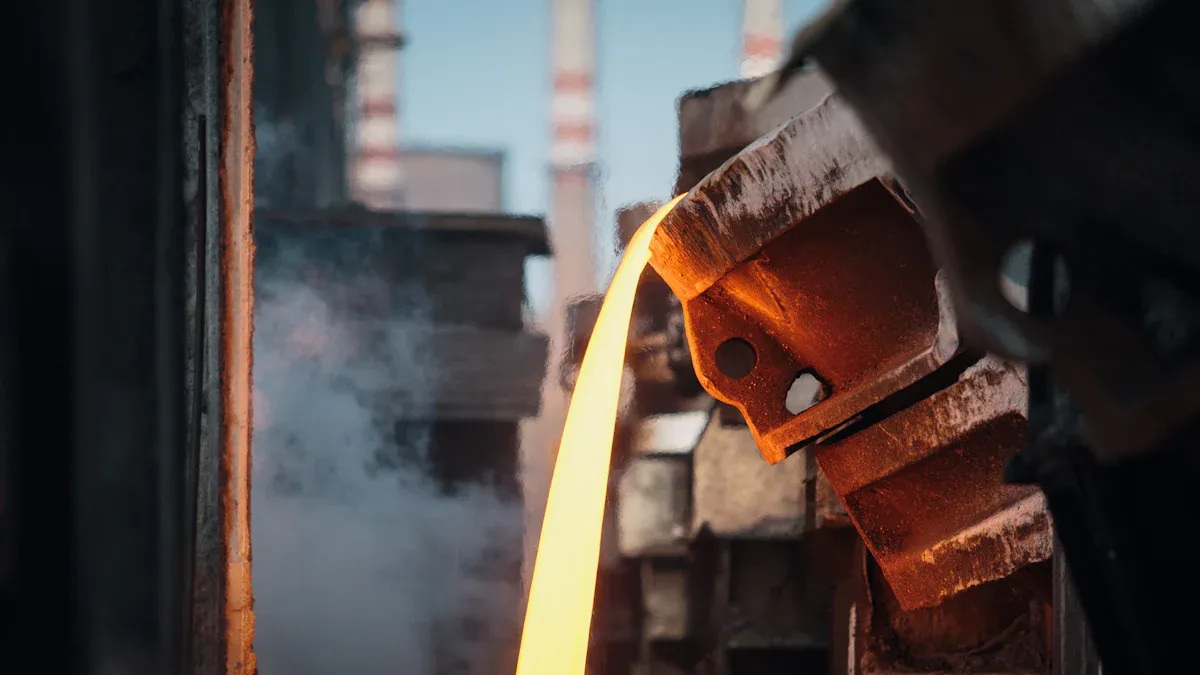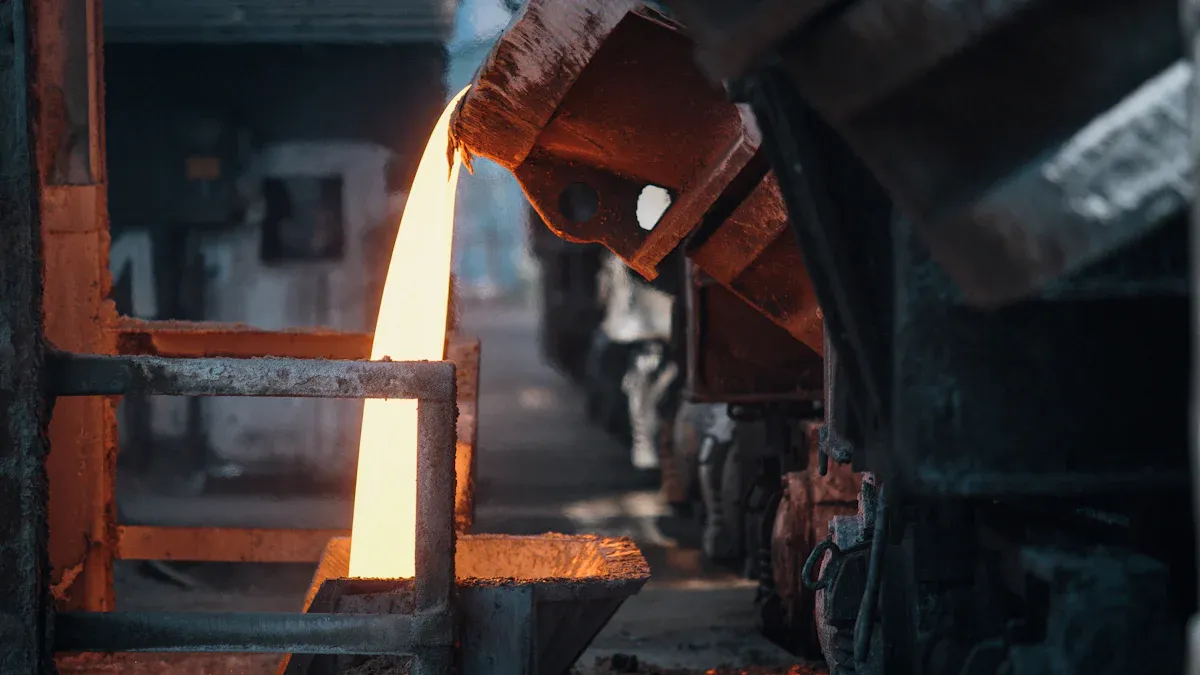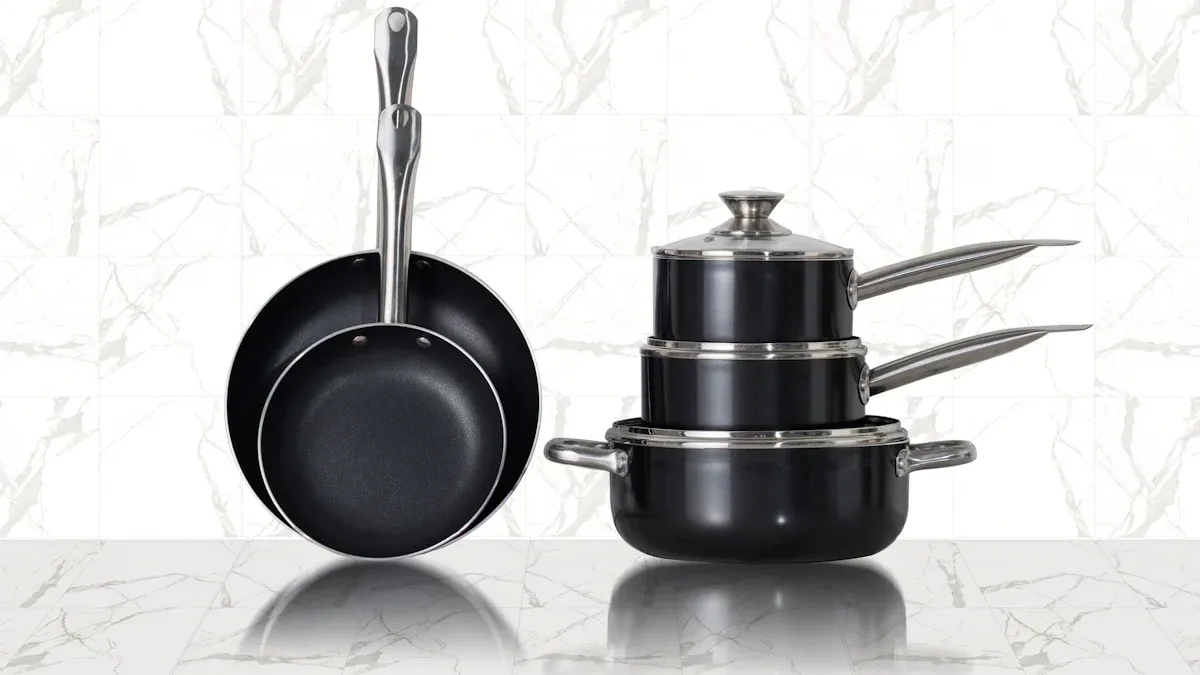
Stainless steel casting plays a critical role in creating durable, corrosion-resistant components for industries ranging from automotive to aerospace. The market for these castings, valued at USD 2.5 billion in 2024, is expected to grow to USD 4.1 billion by 2033. Methods like stainless steel casting lost wax precision castings ensure unmatched precision for complex designs.
Key Takeaways
- Investment casting gives great accuracy, perfect for detailed designs in planes and medical tools.
- Sand casting is the cheapest way, best for big parts or small production batches.
- Centrifugal casting makes strong, flawless round parts that last long.
Overview of Stainless Steel Casting Methods

Investment Casting (Lost Wax Precision Castings)
Investment casting, also known as lost wax precision casting, is a highly accurate method for creating stainless steel components. This process involves creating a wax model of the desired part, coating it with a ceramic shell, and then melting the wax away to leave a mold. Molten stainless steel is poured into this mold to form the final product.
This method stands out for its precision. It achieves tolerances as tight as ±0.05 mm, making it ideal for intricate designs. The surface finish is exceptionally smooth, reducing the need for post-machining. For industries requiring complex shapes, such as aerospace or medical equipment, investment casting offers unmatched benefits.
Key Points:
- High dimensional accuracy (±0.05 mm).
- Smooth surface finish minimizes additional processing.
- Best suited for intricate and detailed designs.
Sand Casting
Sand casting is one of the oldest and most cost-effective methods for producing stainless steel parts. It uses a sand-based mold, which is inexpensive and easy to create. This method is particularly useful for large components or low-volume production runs.
While sand casting lacks the precision of investment casting, it compensates with affordability. The cost of shell-making per kilogram of casting is approximately 5.9 yuan, with material costs accounting for 67.8%. Post-treatment processes, like sand cleaning, add about 3.33 yuan per kilogram. This makes sand casting a practical choice for budget-conscious projects.
Key Points:
- Cost-effective for large or low-volume parts.
- Simple mold creation process.
- Suitable for less intricate designs.
Centrifugal Casting
Centrifugal casting involves pouring molten stainless steel into a rotating mold. The centrifugal force distributes the metal evenly, creating dense and defect-free components. This method is commonly used for cylindrical parts like pipes and rings.
The process ensures excellent material properties, including high strength and durability. It also minimizes impurities, making it a reliable choice for applications requiring robust performance under stress.
Key Points:
- Produces dense, defect-free components.
- Ideal for cylindrical shapes.
- Ensures high strength and durability.
Die Casting
Die casting uses high pressure to inject molten stainless steel into a metal mold. This method is highly efficient for mass production, as it allows for rapid manufacturing of identical parts. The resulting components have excellent dimensional accuracy and surface finish.
However, die casting is best suited for smaller parts due to the high cost of molds. It is widely used in industries like automotive and electronics, where precision and efficiency are critical.
Key Points:
- High efficiency for mass production.
- Excellent dimensional accuracy and surface finish.
- Best for small, high-volume parts.
Detailed Comparison of Methods
Precision and Dimensional Accuracy
Precision plays a vital role in stainless steel casting, especially for industries like aerospace and medical equipment where even minor deviations can lead to performance issues. Among the casting methods, investment casting stands out for its exceptional dimensional accuracy. The Silica Sol Shell Process, used in investment casting, offers high stability and resistance to deformation at elevated temperatures. This makes it ideal for applications requiring tight tolerances. On the other hand, the Water Glass Shell Process, often used in sand casting, provides lower dimensional accuracy and average surface quality, despite advancements in shell coating techniques.
Centrifugal casting also delivers impressive precision, particularly for cylindrical components. The centrifugal force ensures uniform distribution of molten metal, reducing defects and enhancing dimensional consistency. Die casting, while highly accurate for small parts, may struggle with larger components due to mold limitations.
Key Points:
- Investment casting achieves tight tolerances with the Silica Sol Shell Process.
- Sand casting offers lower precision but remains cost-effective.
- Centrifugal casting ensures dimensional consistency for cylindrical shapes.
- Die casting excels in precision for small, high-volume parts.
Cost and Production Efficiency
Cost and production efficiency vary significantly across casting methods. Investment casting, while precise, involves multiple stages like wax pattern creation and ceramic mold production. These processes require specialized materials and equipment, leading to higher production costs. Small and medium enterprises (SMEs) often find these initial setup costs challenging to manage.
Sand casting, by contrast, is one of the most affordable methods. Its simple mold creation process and low material costs make it ideal for budget-conscious projects. Centrifugal casting offers moderate cost efficiency, balancing material quality with production speed. Die casting, though efficient for mass production, demands significant upfront investment in molds, making it less suitable for low-volume runs.
Key Points:
- Investment casting has high setup costs, limiting accessibility for SMEs.
- Sand casting is the most cost-effective option for large or low-volume parts.
- Centrifugal casting balances cost and quality.
- Die casting is efficient for high-volume production but costly for small runs.
Material Properties and Strength
Material properties and strength are critical factors in stainless steel casting, especially for applications requiring durability under stress. Research highlights the mechanical properties of AISI 420 stainless steel, emphasizing its robustness when produced through advanced casting methods. Investment casting ensures excellent material integrity due to its precise mold design and controlled cooling process.
Centrifugal casting produces dense, defect-free components, making it ideal for parts subjected to high pressure or wear. Sand casting, while less precise, can still deliver strong components when paired with post-treatment processes. Die casting offers good strength for smaller parts but may require additional treatments to enhance durability.
| Key Findings | Description |
|---|---|
| Mechanical Properties | AISI 420 stainless steel demonstrates superior durability in advanced casting methods. |
| Process Parameters | Proper selection of process parameters ensures optimal mechanical properties. |
| Defect Analysis | Computed tomography helps identify defects, ensuring material integrity. |
Key Points:
- Investment casting ensures high material integrity.
- Centrifugal casting produces dense, durable components.
- Sand casting benefits from post-treatment processes to enhance strength.
- Die casting offers good strength but may need additional treatments.
Application Suitability
Each casting method has unique applications based on its strengths. Investment casting is perfect for industries requiring intricate designs, such as aerospace and medical equipment. Sand casting works well for large components or projects with budget constraints. Centrifugal casting is the go-to choice for cylindrical parts like pipes and rings, thanks to its defect-free results. Die casting shines in automotive and electronics industries, where precision and efficiency are paramount.
Metrics like Non-Destructive Testing (NDT) and Dimensional Testing help evaluate the success of these methods in industrial applications. For example, tensile testing measures the strength of cast materials, while corrosion testing ensures their longevity in harsh environments.
| Metric Type | Description |
|---|---|
| Non-Destructive Testing (NDT) | Evaluates casting quality without causing damage. |
| Dimensional Testing | Ensures compliance with specifications using advanced tools. |
| Positive Material Identification | Confirms chemical composition of the material. |
| Tensile Testing | Measures strength and deformation capacity under tension. |
| Corrosion Testing | Assesses resistance to corrosion for high-specification applications. |
Key Points:
- Investment casting suits intricate designs in aerospace and medical industries.
- Sand casting is ideal for large, budget-friendly projects.
- Centrifugal casting excels in producing cylindrical components.
- Die casting is perfect for automotive and electronics applications.
Advantages of Each Method

Benefits of Investment Casting (Lost Wax Precision Castings)
Investment casting, also known as lost wax precision casting, offers unmatched precision and versatility. This method excels in producing intricate designs with tight tolerances, making it a favorite for industries like aerospace and medical equipment. The process ensures a smooth surface finish, reducing the need for extensive post-processing.
One of its standout advantages is its ability to handle complex geometries. Components with thin walls, internal cavities, or detailed features can be cast with ease. Additionally, investment casting supports a wide range of stainless steel alloys, allowing manufacturers to tailor material properties to specific applications. While the initial setup costs may be higher, the long-term benefits, such as reduced machining and material waste, often outweigh the expenses.
Tip: For projects requiring high precision and intricate designs, investment casting is the go-to method.
Key Points:
- Delivers exceptional precision and smooth surface finishes.
- Ideal for complex geometries and detailed designs.
- Supports a variety of stainless steel alloys for tailored applications.
Benefits of Sand Casting
Sand casting stands out for its cost efficiency and adaptability. This method is particularly effective for producing large components or handling low-volume production runs. The molds, made from sand, are inexpensive and easy to create, making this method accessible for budget-conscious projects.
Compared to other methods, sand casting offers improved production efficiency. The table below highlights how it compares to die casting in terms of cost and production:
| Aspect | Sand Casting | Die Casting |
|---|---|---|
| Cost Efficiency | Reduced costs | Higher initial costs |
| Production Efficiency | Improved production efficiency | Lower production efficiency |
While sand casting may not achieve the same level of precision as investment casting, it compensates with its ability to produce large and robust components. Post-treatment processes, such as sand cleaning and machining, can further enhance the quality of the final product.
Key Points:
- Cost-effective for large or low-volume parts.
- Simple and affordable mold creation process.
- Suitable for producing robust components with post-treatment options.
Benefits of Centrifugal Casting
Centrifugal casting is the method of choice for cylindrical components like pipes, rings, and bushings. By using centrifugal force to distribute molten metal evenly, this process creates dense, defect-free parts with excellent mechanical properties. The resulting components exhibit high strength and durability, making them ideal for applications subjected to extreme stress or wear.
Another advantage of centrifugal casting is its ability to minimize impurities. The spinning motion forces lighter impurities to the surface, which can then be removed during finishing. This ensures the integrity of the material and enhances its performance in demanding environments.
Note: Stainless steel’s corrosion resistance and durability make it a versatile material for centrifugal casting. Despite higher initial costs, its long-term value often surpasses alternatives like aluminum or galvanized steel.
Key Points:
- Produces dense, defect-free components with high strength.
- Ideal for cylindrical shapes like pipes and rings.
- Minimizes impurities for enhanced material integrity.
Benefits of Die Casting
Die casting is synonymous with efficiency and precision, especially for small, high-volume parts. This method uses high pressure to inject molten stainless steel into metal molds, enabling rapid production of identical components. The resulting parts boast excellent dimensional accuracy and surface finish, reducing the need for secondary operations.
While die casting involves significant upfront investment in molds, its efficiency in mass production makes it cost-effective for large-scale projects. Industries like automotive and electronics rely heavily on this method for its ability to produce lightweight, precise, and durable components.
Tip: For projects requiring high-volume production with consistent quality, die casting offers a reliable solution.
Key Points:
- Highly efficient for mass production of small parts.
- Delivers excellent dimensional accuracy and surface finish.
- Best suited for industries like automotive and electronics.
Choosing the Right Method
Factors to Consider (Geometry, Cost, Application Needs)
Selecting the right stainless steel casting method depends on several key factors. Each method offers unique advantages, but the decision should align with the specific requirements of the project. Here are the primary considerations:
| Factors Influencing Decision-Making | Description |
|---|---|
| Design Complexity | Intricate designs may require methods like investment casting for precision. |
| Production Volume | High-volume production often benefits from die casting’s efficiency. |
| Material Properties | The desired strength, durability, or corrosion resistance impacts the choice. |
| Cost Constraints | Budget limitations can steer decisions toward cost-effective methods like sand casting. |
| Required Surface Finish | Applications needing smooth finishes may favor investment or die casting. |
For example, investment casting excels in creating complex geometries, while sand casting is better suited for simpler, larger parts. Centrifugal casting works well for cylindrical components, and die casting is ideal for small, high-volume parts. Matching the method to the geometry, cost, and application needs ensures optimal results.
Key Points:
- Consider design complexity, production volume, and material properties.
- Align the method with budget and surface finish requirements.
Real-World Examples of Method Selection
Industries rely on stainless steel castings for diverse applications, and the choice of method often depends on specific needs:
- Medical Implants: Investment casting is used for hip replacements due to its precision and ability to handle biocompatible materials like stainless steel 316.
- Heavy Machinery: Sand casting produces gears and shafts that withstand high mechanical loads, emphasizing the importance of geometry and strength.
- Chemical Processing: Centrifugal casting creates pumps and reactor vessels that resist corrosion and high temperatures.
Advancements in casting technology have also improved productivity and reduced costs. For instance, focusing on quality in filling systems has led to annual financial savings of $94,323 and a reduction of 3 tons in CO2 emissions. These examples highlight how selecting the right method can enhance performance and sustainability.
Key Points:
- Investment casting suits intricate medical implants.
- Sand casting is ideal for heavy machinery components.
- Centrifugal casting excels in chemical processing applications.
Tips for Optimizing Casting Results
Achieving the best results in stainless steel casting requires careful planning and execution. Here are some practical tips:
- Prioritize Quality in Filling Systems: High-quality filling systems reduce defects and improve material integrity, leading to better performance and financial savings.
- Use Advanced Testing Methods: Techniques like Non-Destructive Testing (NDT) and computed tomography help identify defects early, ensuring higher-quality castings.
- Select the Right Alloy: Matching the stainless steel alloy to the application enhances durability and corrosion resistance.
- Leverage Simulation Tools: Casting simulation software predicts potential issues, allowing adjustments before production begins.
Industry reports also emphasize the importance of controlling inclusion content during the casting process, especially for critical applications like bio-pharmaceutical services. Following these best practices can significantly improve casting outcomes.
Key Points:
- Focus on quality in filling systems and testing methods.
- Choose the right alloy and use simulation tools for better results.
Stainless steel casting methods offer distinct advantages that cater to different needs. Investment casting delivers unmatched precision, making it ideal for intricate designs. Sand casting and centrifugal casting provide cost-effective solutions for larger or cylindrical components.
| Advantage | Description |
|---|---|
| Corrosion Resistance | Highly resistant to corrosion, ideal for durable applications. |
| Strength and Durability | Strong material that withstands extreme temperatures and high pressure. |
| Versatility | Can create a wide range of shapes and sizes, popular among manufacturers. |
| Precision | Allows for high precision and accuracy, preferred for parts requiring tight tolerances. |
| Cleanliness | Hygienic and easy to clean, suitable for food processing and medical applications. |
Choosing the right method ensures optimal performance, durability, and cost-efficiency for any application.
FAQ
What is the most precise stainless steel casting method?
Investment casting offers the highest precision. It achieves tight tolerances and smooth finishes, making it ideal for intricate designs in industries like aerospace and medical equipment.
Which casting method is the most cost-effective?
Sand casting is the most budget-friendly option. Its simple mold creation process and low material costs make it perfect for large components or low-volume production runs.
How do I choose the right casting method?
Consider the design complexity, production volume, and material properties. For intricate designs, choose investment casting. For cylindrical parts, centrifugal casting works best. Budget-conscious? Sand casting is ideal.
